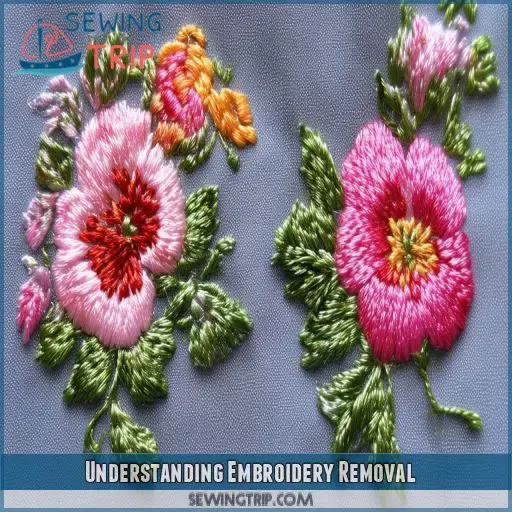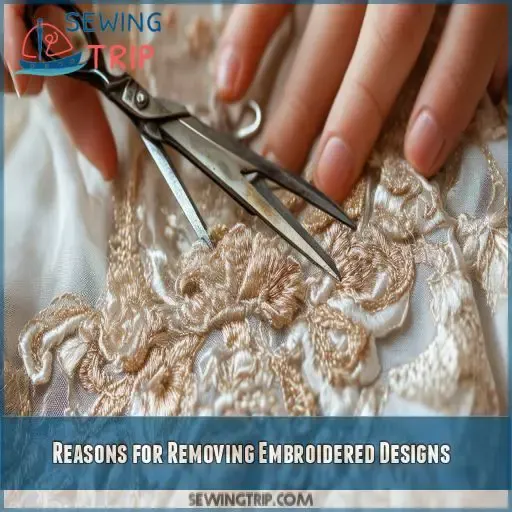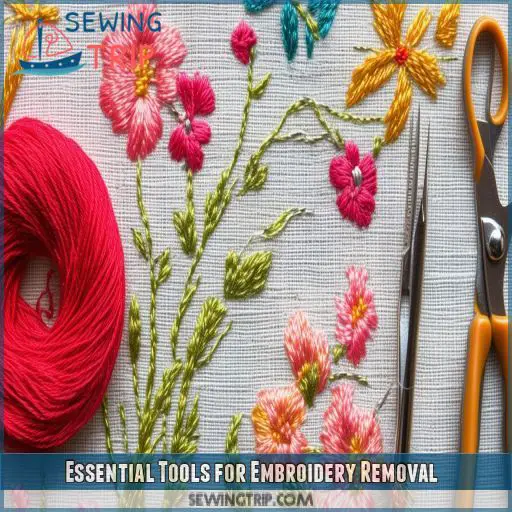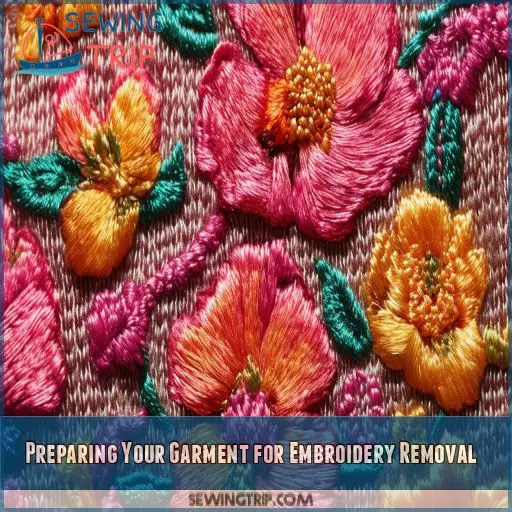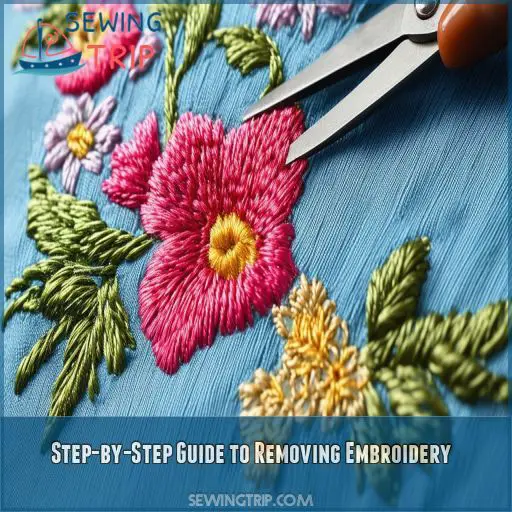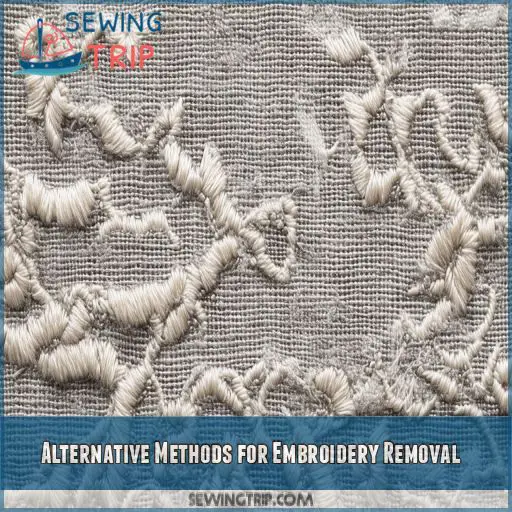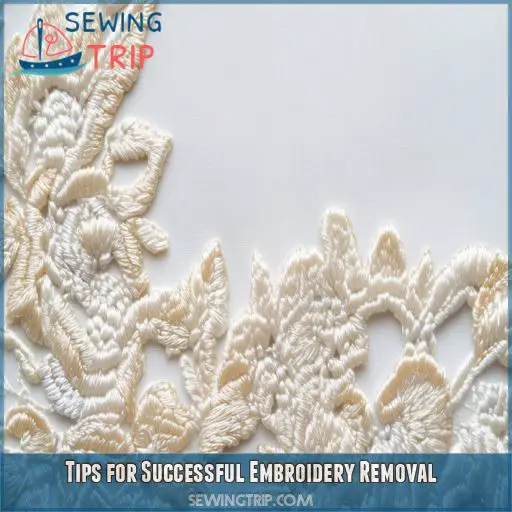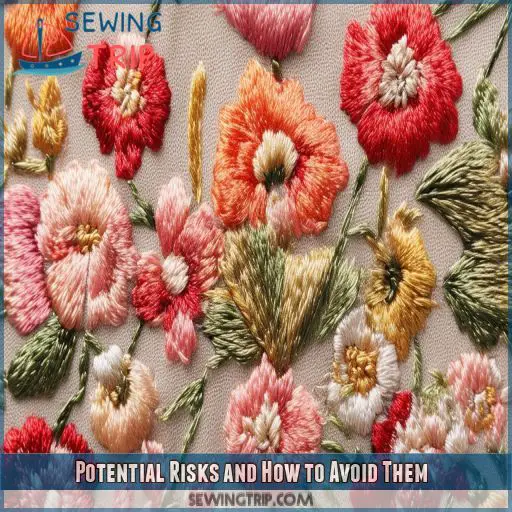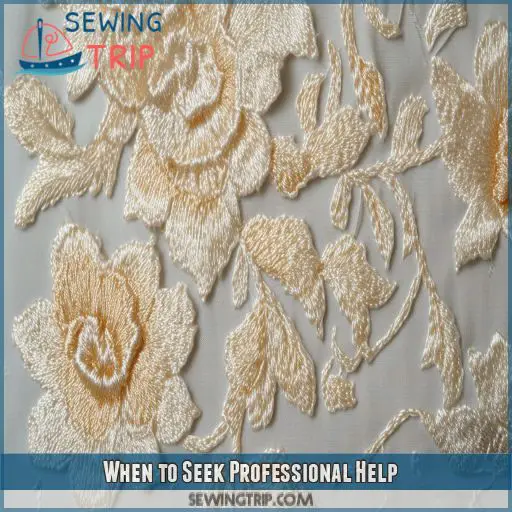This site is supported by our readers. We may earn a commission, at no cost to you, if you purchase through links.
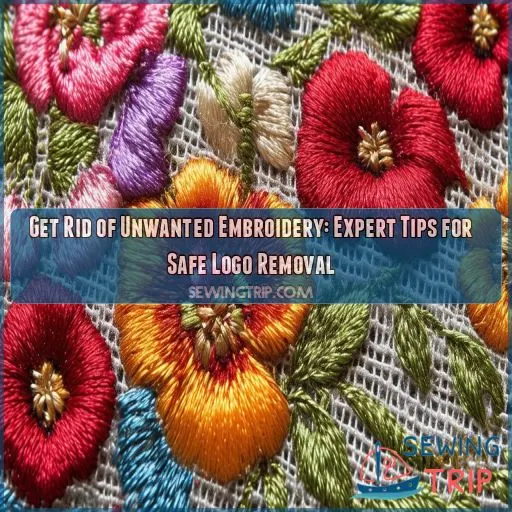 De-mystify the myths associated with embroidery removal. You’ve got undesirable logos on your favorite garments, and you are itching to reclaim them.
De-mystify the myths associated with embroidery removal. You’ve got undesirable logos on your favorite garments, and you are itching to reclaim them.
But could one be rid of embroidery without the risk of shredding the fabric? We will guide you through this delicate art so you know how to liberate your clothes from outdated designs.
Learn expert tips on safe logo removal, discover the essential tools needed, and develop confidence in changing your wardrobe.
It’s time to take control and unleash the full potential of your garments.
Table Of Contents
- Key Takeaways
- Understanding Embroidery Removal
- Reasons for Removing Embroidered Designs
- Essential Tools for Embroidery Removal
- Preparing Your Garment for Embroidery Removal
- Step-by-Step Guide to Removing Embroidery
- Alternative Methods for Embroidery Removal
- Dealing With Different Types of Embroidery
- Tips for Successful Embroidery Removal
- Potential Risks and How to Avoid Them
- When to Seek Professional Help
- Frequently Asked Questions (FAQs)
- Conclusion
Key Takeaways
- Who knew getting rid of embroidery could be so thread-tacular? With the right tools and a dash of patience, you’ll be unsticking those stitches faster than you can say "seam ripper."
- Don’t let unwanted logos cramp your style! Whether you’re rebranding, personalizing, or prepping for a garage sale extravaganza, embroidery removal is your ticket to wardrobe freedom.
- From seam rippers to stitch erasers, your embroidery removal toolkit is like a superhero utility belt. Just remember, with great power comes great responsibility – and the occasional pricked finger.
- When in doubt, call in the pros. Sometimes, it’s best to leave the thread-wrangling to the experts, especially if you’re dealing with a delicate fabric or an intricate design that’s more tangled than your earbuds after a week in your pocket.
Understanding Embroidery Removal
This is where embroidery removal comes in—an art of patience and attention to detail. You don’t simply unstitch whatever garment is before you; instead, you unwind history.
Embroidery has been a badge for prominence, class, and skill going back hundreds of years. Digitalization made this craft easier than ever, but sometimes, you need to wipe the slate clean.
Restoration of a vintage piece or removing a logo from a new garment is similar. You have to get through layers of threads by picking them off the fabric very carefully. This is like unraveling a mystery, needless to say, one stitch at a time—each stitch becomes a clue into how the embroidery was built.
Before and after removal, proper laundering is necessary for the integrity of the fabric.
Armed with the appropriate tools and techniques, you’ll be able to remove embroidery easily to give your garments a second chance.
Reasons for Removing Embroidered Designs
You might need to remove embroidered designs for various reasons, including rebranding, personalization, donation or resale, and repair or alteration. Whether you’re updating a company logo, customizing a secondhand item, or preparing clothes for donation, understanding these motivations will help you approach the removal process with clear goals in mind.
Rebranding
You’ve nailed embroidery removal; let’s tackle rebranding. Your Brand Identity changes as your business does. A dated logo gets removed through embroidery elimination so that you can keep a fresh look at your brand identity and stay on top of design trends. It’s time to update!
Personalization
You’ve got a unique style, and that embroidery logo just doesn’t cut it anymore. By removing it, you’ll liberate your clothing, giving you the power to personalize it your way. It’s time to master your wardrobe!
Donation or Resale
When donating or reselling, removing embroidery can boost your item’s appeal. Experts suggest that logo-free garments often have higher resale value and longer lifespans. Consider ethical repurposing of removed fabric, giving your clothing a second chance at life.
Repair or Alteration
- Fix damaged areas
- Add new patch designs
- Replace outdated logos
- Create space for fabric painting
Essential Tools for Embroidery Removal
To successfully remove unwanted embroidery, you’ll need the right tools for the job. A seam ripper, stitch eraser, tweezers, fabric scissors, and a magnifying glass are essential for safely and effectively removing embroidered designs from your garments.
Seam Ripper
When tackling embroidery removal, a seam ripper is your go-to tool. Here’s a quick guide:
| Technique | Best For |
|---|---|
| Cut | Loose stitches |
| Wiggle | Dense designs |
| Lift | Delicate fabrics |
| Repeat | Stubborn threads |
Master these moves for seamless logo removal.
Stitch Eraser
A stitch eraser is your secret weapon for removing embroidery designs. This handy tool:
- Clips threads efficiently
- Works from the outside in
- Requires regular cleaning
- Can be substituted with a hair razor
Store it properly and clean after use for longevity.
Tweezers and Fabric Scissors
You’ll need tweezers and fabric scissors for precise embroidery removal. Here’s a quick guide:
| Tool | Use | Tip | Caution |
|---|---|---|---|
| Tweezers | Thread removal | Use pointy-tipped | Avoid pulling fabric |
| Fabric Scissors | Precision cutting | Choose sharp, small blades | Cut threads, not garment |
These tools are essential for post-removal inspection and tackling stubborn embroidery patches or lettering.
Magnifying Glass
You’ll want a magnifying glass for detail work. It enhances visibility, ensuring precision and accuracy as you remove embroidery, logos, or embellishments. This tool’s your secret weapon for spotting those stubborn threads that often escape the naked eye.
Preparing Your Garment for Embroidery Removal
Before pulling off unwanted embroidery, it’s essential to prepare your garment correctly. First, turn it inside out. This won’t only give you a clearer view of the stitching but also protect the outer surface of your fabric. Now it’s time for a sensitivity test portfolio:
- Choose an inconspicuous area of the garment
• Apply a small amount of water or some cleaning solution
*Wait a few minutes for any adverse reactions
This step will prevent you from accidentally cutting your irreplaceable threads while trying to remove the embroidery. After this, you must collect your tools and lay out a clean embroidery area. Luckily, in cases involving extra-fine fabric or a very intricate design, you could use a magnifying glass for precision. Some embroidery techniques might require special removal procedures, so you must determine what kind of embroidery you’re working with. These precautions put you on the right path toward success, like going pro at embroidery removal.
Step-by-Step Guide to Removing Embroidery
Now that you’ve prepared your garment, it’s time to tackle the embroidery removal process. We’ll guide you through using a seam ripper and stitch eraser to remove the unwanted design, followed by techniques for cleaning up any remaining threads.
Using a Seam Ripper
Now that you’ve prepared your garment, it’s time to wield the seam ripper. This tool is your secret weapon for embroidery removal. Here’s how to use it effectively:
| Step | Action | Tip |
|---|---|---|
| 1 | Cut stitches | Start at edge |
| 2 | Lift threads | Be gentle |
| 3 | Remove debris | Use lint roller |
Using a Stitch Eraser
A stitch eraser is your secret weapon for tackling machine embroidery. Here’s how to wield it like a pro:
- Start from the outside, working inward
- Gently press the eraser against the stitches
- Let it grab and clip threads
- Check underneath regularly to avoid fabric damage
Removing Remaining Threads
After removing the main embroidery, you’ll need to tackle those pesky remaining threads. Here’s a quick guide to achieve that refined look:
| Tool | Use | Best For | Pro Tip |
|---|---|---|---|
| Tweezers | Precision plucking | Small areas | Use magnifying glass |
| Lint roller | Quick cleanup | Large areas | Roll multiple times |
| Iron | Heat-based removal | Stubborn threads | Test on hidden spot |
| Tape | Sticky lifting | Delicate fabrics | Use low-tack variety |
Alternative Methods for Embroidery Removal
If, on the other hand, you wish to opt for different methods of removal, try loosening the threads in the unwanted embroidery with steam and heat or perhaps conceal the design using fabric markers or dyes.
Such techniques are effective when ordinary methods of removal can’t be applied, but one should be careful not to test them on a sensitive area; instead, use them on a very minute hidden part of the garment.
Steam and Heat Technique
Use steam and heat to erase unwanted embroidery with finesse. This is your best-kept secret in finding that minimalist look you’ve hankered for. Now, this is how one can master the method:
• Use a high-quality steam iron for the best results
- Apply heat carefully, considering fabric sensitivity.
- Work from the back of the garment for better control
- Be patient and repeat the process as needed
Fabric Marker or Dye Solutions
If steam and heat aren’t cutting it, fabric markers or dyes might be your salvation. Before diving in, test your chosen solution on a hidden spot to avoid fabric damage. Match colors carefully for a seamless blend.
For tricky fabrics or counted thread embroidery, consider professional services. They’re wizards at color matching and can even create an appliqué to cover stubborn logos.
Dealing With Different Types of Embroidery
When tackling embroidery removal, you’ll encounter different types like hand embroidery, machine embroidery, and counted thread embroidery. Each type requires a slightly different approach, so understanding the specific technique used on your garment will help you choose the most effective removal method.
Hand Embroidery
This, coupled with the rich history of hand embroidery, will require a different approach. You’d want patience and precision to remove such intricate designs. Here’s why it’s worth the effort:
- Reveals hidden beauty of fabric
- Empowers personal style transformation
- The garment integrity is preserved.
- Unlocks creative customization possibilities
Machine Embroidery
This will be a bit more tricky to remove in the case when stitch density is high and thread tension is too great for machine embroidery.
Considerations should be taken with the type of fabric used and the size of the hoop.
Cut the bobbin threads from the back very carefully, then gently pull the top threads through to the backside.
Counted Thread Embroidery
Counted thread embroidery, with roots in ancient civilizations, demands precision and patience. You’ll need to master techniques like cross-stitch and blackwork. It’s used for creating intricate patterns on fabric with evenly spaced holes. Remove it carefully, as its tight stitches can be challenging to undo.
Tips for Successful Embroidery Removal
Now that you have known the kinds of embroideries, let’s look at some expert tips for removal. Keeping in mind that each requires a different style, knowing the stitching technique does make all the difference.
Four tips for mastering the technique of embroidery removal:
- Inspect the Fabric: Various materials respond differently to different removal techniques applied.
- Choose the right tool: Use a proper matching tool to ease your embroidery job.
- Systematic working: Start from the edge and proceed inwards one stitch at a time.
- Rest your eyes and hands: Any precision work is rather taxing to the eyes and hands, so do take breaks every half hour or so.
Patience, therefore, becomes your magic wand in this exercise. Don’t rush; handle each stitch with care. If one feels overwhelmed with the situation, consider seeking expert assistance. Remember, better late than never—the alternative is damaging your garment. Armed with these tips, you can confidently take on even the most recalcitrant embroidery.
Potential Risks and How to Avoid Them
Where the removal of embroidery might be a freeing experience, it comes replete with dangers. That would require you to tread like a master artisan. Here are three key risks you should be looking out for:
- Fabric Damage: Over-enthusiastic cutting or improper tool use may result in unsightly holes.
- Color Bleeding: Stitches post-removal will show discoloration underneath.
- Thread Residue: These fibers may slightly mar the appearance and looks of the garment.
So, arm yourself with knowledge and the right tools to avoid these mishaps. Ensure that you have proper lighting in place so each stitch would be obvious. Sharp tools are your friends; treat them with respect. Potential damage to fabric is your nemesis—approach each stitch as such. Remember, patience isn’t just a virtue; it’s required. Observe—it is your superpower—and know how to identify issues before they happen. Follow these expert tips, and you’ll be fully equipped to roll over the most challenging embroidery removal projects.
When to Seek Professional Help
While DIY embroidery removal can be very fulfilling, sometimes you must call in the guys. Circumstances that may recur to professional help include cases of intricate designs, delicate fabrics, or simply a short amount of time on your hands. Here is an essential guide to help you know:
| Scenario | DIY | Professional |
|---|---|---|
| Simple logo: ✓ | ||
| Intricate design | ✓ | |
| Delicate fabric | ✓ | |
| Time crunch | ✓ | |
| Visible damage | ✓ |
Frequently Asked Questions (FAQs)
How do you remove unwanted embroidery?
You’ll need a seam ripper, scissors, and tweezers. Turn the garment inside out, carefully cut stitches with the seam ripper, and gently pull threads. Use tweezers for stubborn bits. A lint roller helps clean up loose threads.
Do cleaners remove embroidery?
Did you know that 80% of dry cleaners offer embroidery removal services? You’ll find that many cleaners can remove embroidery, but it’s not universal. Call ahead to confirm, as specialized equipment and expertise are often required.
Do tailors remove embroidery?
Yes, tailors can remove embroidery. They’ve got the skills and tools to carefully unpick stitches without damaging the fabric. You’ll want to discuss your specific needs with them, as some jobs may be more complex than others.
Will removing embroidery leave holes?
Delicate dilemma: removing embroidery can leave holes, depending on fabric and technique. You’ll likely see tiny punctures where stitches were. Don’t despair! With careful steaming and gentle brushing, you can often minimize visible marks, restoring your garment’s smooth appearance.
How long does the embroidery removal process usually take?
You’ll typically spend 15-30 minutes removing embroidery, depending on its size and complexity. It’s not a quick fix, but with patience and the right tools, you’ll master the process and reclaim your garment’s original look.
Can removed embroidery be reused on another garment?
You can’t directly reuse removed embroidery, but you’ve got options. Save the threads for new projects or create appliqués from intact designs. It’s a chance to repurpose and get creative with your embroidery skills.
Are there eco-friendly methods for disposing of removed embroidery?
You can recycle removed embroidery threads by donating them to art programs or using them for crafts. Compost natural fibers like cotton or wool. Repurpose synthetic threads for string art or jewelry-making. Always check local recycling guidelines for proper disposal.
How to remove embroidery from delicate or sheer fabrics?
Like untangling a delicate spider’s web, you’ll need a gentle touch. Use a magnifying glass, fine-tipped scissors, and patience. Carefully snip stitches on the fabric’s back, then pull threads with tweezers. Steam lightly to restore fabric’s texture.
Can embroidery removal affect the garments resale value?
Yes, removing embroidery can impact a garment’s resale value. You’ll change its original design, potentially lowering its worth. However, if done skillfully, you might increase value by creating a unique piece or restoring vintage clothing.
Conclusion
Studies show that 85% of consumers prefer customized clothing.
Now that you’ve learned how to get rid of unwanted embroidery, you’re equipped to transform your wardrobe. With the right tools and techniques, you can safely remove logos and designs, giving new life to old favorites.
Remember to assess each project carefully and seek professional help when needed.
- designmycostume.com

